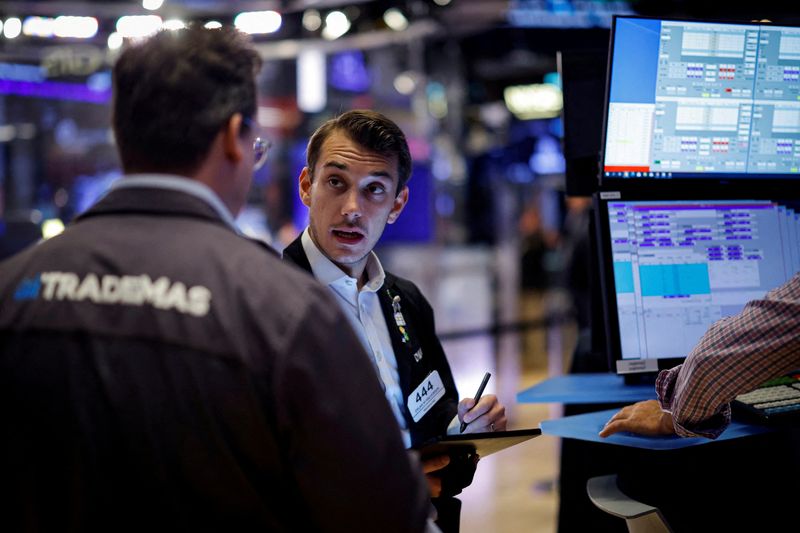By Samuel Indyk and Koh Gui Qing
NEW YORK/LONDON (Reuters) – Global stocks rose on Wednesday, lifted by a rise in technology stocks after U.S. President Donald Trump announced huge spending plans for artificial intelligence infrastructure, while the dollar rose collapsed to its lowest level in two weeks due to the postponement of customs tariffs.
On Tuesday evening, Trump announced that OpenAI, Japan’s SoftBank (TYO:) and Oracle (NYSE:) would form a joint venture and invest up to $500 billion to build AI data centers.
SoftBank shares jumped 10.6% in Tokyo, while Oracle gained 7.6% on Wall Street, adding to Tuesday’s 7.2% jump.
Those gains helped push the tech-heavy Nasdaq up 1.3%. The benchmark index rose 0.6% after hitting a record high earlier, and added 0.3%. The MSCI world stock index rose 0.5%.
Even though global stock markets are near record highs, some investors have said they could rise further.
“We prefer to take risks on stocks and expect corporate earnings to continue generating returns as the fourth-quarter earnings season begins,” said Jean Boivin, director of BlackRock (NYSE:) Investment Institute, adding that Treasury yields could rise.
“We are in a world of higher interest rates and we expect them to remain above pre-pandemic levels. Even with rising yields, we still see more room to maneuver, albeit at a slower pace,” Boivin said.
The benchmark index rose 3.9 basis points to 4.5820%.
European stocks were higher despite threats of U.S. tariffs on imports, with Trump again vowing to hit the European Union with new levies. But Europe was breathing a sigh of relief as many foreign investors and capital expected the tariffs to be implemented on the first day Trump took office, as he had promised. during his campaign.
“Trump seems more focused on his country and Europe is getting a stay of execution,” said Eddie Kennedy, head of bespoke discretionary fund management at Marlborough. “Therefore, I think it makes sense to have a small gathering.”
The pan-continental rose 0.4% after hitting an intraday record. Blue chips Frankfurt and London also hit new intraday highs before retreating.
European infrastructure stocks, such as Schneider Electric (EPA:) and Prysmian (BIT:), have been among the top performers in Trump’s AI investment campaign.
Investments in AI have increased since OpenAI launched ChatGPT in late 2022, driving up the stock prices of chipmakers and those building the infrastructure, helping to drive gains in the broader market.
In Asia, 225 rose 1.6%, driven by a nearly 11% rise in SoftBank shares.
MSCI’s broadest index of Asia-Pacific shares outside Japan, however, was flat, as declines in Chinese and Hong Kong stocks offset big gains elsewhere.
Trump said his administration was considering imposing punitive 10% duties on Chinese imports because fentanyl is shipped from China to the United States via Mexico and Canada.
Chinese blue chips fell 0.9% and Hong Kong blue chips lost 1.6%.
DOLLAR FALLS TO TWO-WEEK LOW
Trump’s delay in imposing tariffs on major economies pushed the dollar to a two-week low against a basket of currencies.
The , which measures the currency against six other currencies, was little changed at 108.24, after falling to its lowest level since January 6 at 107.75.
The dollar “sold off in response to the lack of clear tariff news on day one, although it is difficult to discern how much of this move is a partial unwinding of long dollar positioning and how much This is a more lasting reassessment of pricing risks by the market. ” said Stuart Jenkins, FX strategist at Goldman Sachs.
The euro was at $1.040950, after hitting $1.0457, its highest level since December 30.
The dollar rose 0.7% to 156.52 yen after falling to a one-month low in the previous session.
Japan’s currency has recently strengthened against the dollar, supported by growing expectations that the Bank of Japan will raise interest rates at its policy meeting on Friday.

In the commodities sector, oil prices were down slightly, after falling more than 2% on Tuesday due to Trump’s plans to boost U.S. energy production. stabilized 0.48% at $78.91 per barrel, while it fell 0.59% to $75.38.
remained stable at $2,755.2351 an ounce, after reaching its highest level since October, due to uncertainty surrounding Trump’s policy plans.

